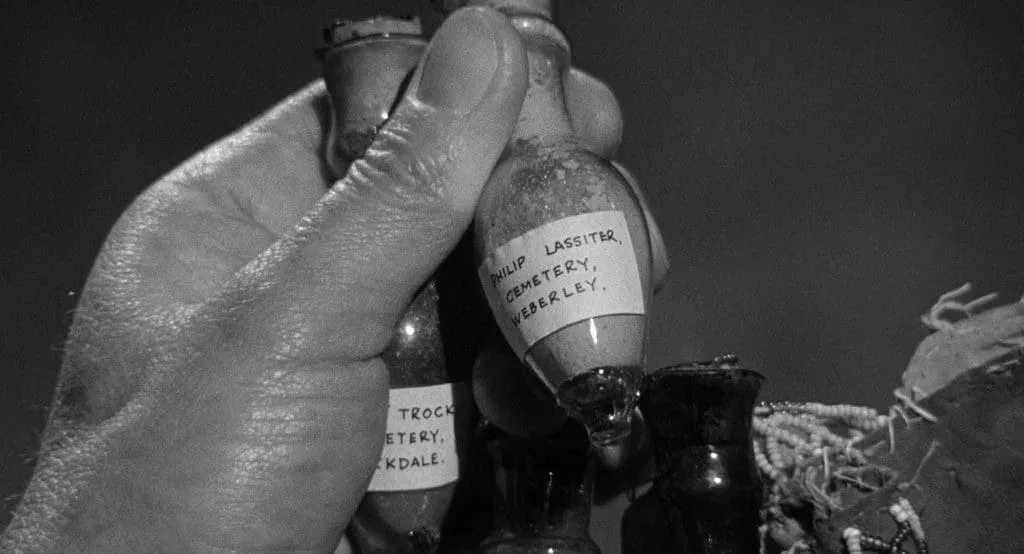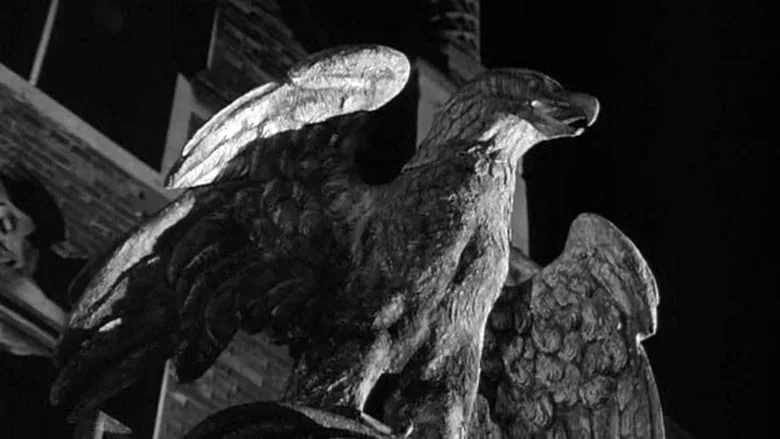Editor’s note: this article contains a full discussion of Night of the Eagle and as such contains spoilers.
“I DO NOT BELIEVE” are the first words both spoken and seen in Night of the Eagle. These words are the crux of a lecture being given by Professor Norman Taylor (Peter Wyngarde), a rational man who is deeply cynical about the new wave of magical thinking already diffusing through society by the 1960s. However, by this point in time, the supremacy of science and rationalism was already fraught with problems; as Taylor acknowledges, magic may have let the genie out of the lamp, but science was by then poised to unleash nuclear warfare. It’s the first acknowledgement of a broader malaise which filters through in the film: although it’s a microcosm, real-life concerns, such as professionalism and promotion, collide with the prospect of older, supernatural forces, and the end result is great anxiety and risk for all concerned.
Taylor is a success story, with a successful career, a beautiful and charming wife (Janet Blair) and two homes, although it’s wife Tansy, in the main, who seems to use their seaside cottage. He’s also in the frame for promotion within the university, despite a few problems rumbling along in his life – a female student who seems to be skating dangerously close to an inappropriate interest in him, her envious (and academically weak) boyfriend and perhaps most insidiously of all, other women in his life – colleagues and the wives of colleagues – who are bastions of passive-aggressive carping and bitter jealousy regarding him, though with characteristic 60s swagger, Taylor brushes this off, perhaps too readily. Tansy is less convinced, regarding one of the wives in particular as a ‘middle-aged Medusa’, but it seems that she has her secrets, too.
Appearances can be deceptive…

The overriding feeling in Night of the Eagle is one of the loss of control: for me, it’s very difficult not to sympathise with Taylor – and by extension, the (largely) orderly world in which we live – as rule, principle and procedure dissipate. Suddenly, the world begins to move very fast; emotions spill over, rules are broken, even technology becomes unsafe. In a few deft moves which take place off-screen, the Taylors’ home is suddenly stripped of its modern conveniences. We even get a bit of pathetic fallacy – check out the ominous storm which precedes the first big scare and voila, a picturesque cottage in 60s Britain becomes a Gothic castle, complete with a malevolent thing on the doorstep, trying to get in – whilst making surely one of the most terrifying sounds ever committed to celluloid. But there’s no simple escape: when the lights come back on, even the analogue tech itself has become a conduit for black magic, a theme which returns right up to the film’s climactic scenes. The twentieth century is stripped back and pushed down into the murky past.
The dawning of the age of…
Unquestionably, Cold War era paranoia holds hands with magic in Night of the Eagle, from the moment it’s invoked in the first scene of the film until the very last scenes. It’s signposted once, but it lingers in the film throughout. The idea of people who look like us and act like us, but harbour destructive secrets and want to overthrow us by any means is something integral to so many films of the era. However, this also shows parity with the beliefs of the past, when it was witchcraft which threatened to do the same thing. At this time too, the irony is that the very real fear of the four-minute warning was very likely to have made people drift away from the rationalism which had made such a thing possible, even likely. The early 60s were already seeing a steady resurgence of interest in new-old religions, magic and paganism. This is the difficult impasse which seems to form the backbone of Night of the Eagle: the dark side of rationalism led people to look to the past, but the practices of the past they resurrected brought additional paranoia and the threat of harm. These things cast their shadows over the film, whether overtly or covertly. Night of the Eagle also excels, via its script, at reminding us just how long our relationship with magic has been. It’s thoroughly interwoven with our language, and it’s there in the dialogue: ideas are ‘bewitching’, people act as ‘good luck charms’, people laughingly suggest people ‘sell their soul to the devil’ for a good outcome. The script is simply able to add the phrase ‘we can press a button’, and we know now what that signifies, too.
“Witch or woman, what was it?”


Folk horror and Night of the Eagle
This idea of precarious modernity is at the heart of a great deal of folk horror, and to my mind Night of the Eagle does share enough common ground here to qualify as folk horror – even if an outlier in a sub-genre which proves tricky to pin down anyway. First of all, Night of the Eagle does an excellent job of making the viewer feel nettled, uneasy – the way which Things are Supposed to Be is balanced on a knife-edge, and these things come tumbling down in quick succession. The creeping influence of witchcraft is making its way into modern life, content to kill those who stand in its way. In fact, here we have magical practices arriving on British shores thanks to a modern global network and the possibilities attached to an academic career: modernity has created the conditions necessary for this malevolent magic to thrive. The ancient college buildings and the clearly ancient cottage inhabited by the Taylors may now be modern in outlook and trappings, but they still become subsumed by ritual practices and supernatural dangers – those modern trappings even facilitate magic. Old and new are again united in the film.

This tense yet ambiguous film doesn’t waste a frame, yet it still leaves us with questions. At the end of the film, there’s a delicious circularity in seeing Taylor sprawled against the same blackboard where “I DO NOT BELIEVE” is still written. One of those four words is obliterated as he presses, in wild-eyed terror, against it; the muddled message which remains, by accident or design, is perhaps the best way to summarise this fantastic film.
